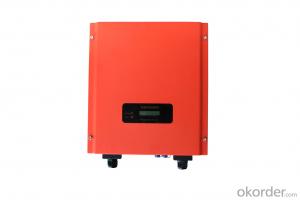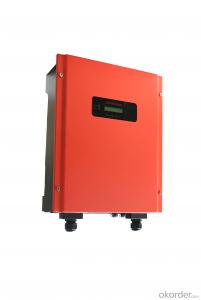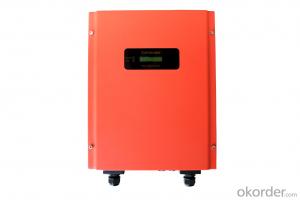PV Inverter Sunteams 1500-3000
- Loading Port:
- China Main Port
- Payment Terms:
- TT OR LC
- Min Order Qty:
- -
- Supply Capability:
- -
OKorder Service Pledge
OKorder Financial Service
You Might Also Like
The Sunteams 1500 ~5000 series isapplicable to various rooftops and small scale photovoltaic grid-connectedpower plants. Their nominal output powers are 1.5 kW, 2 kW, 2.5 kW, 3 kW, 3.6 kW, 4 kW and 5kW respectively.
This series is transformerless and has a wide range of MPPT input voltage. Itsmaximum conversion efficiency and MPPT tracking accuracy reach 97.6 % and 99.5% respectively. The maximum DC voltage reaches 550 V. Its multilingualLCD display facilitates easy operation. It has waterproof direct plug interminals. It has overvoltage, islanding, short circuit, overloading andoverheating protection functions. Its IP65 protection degree will ensure itruns well in various tough environments.
These units are available with or without wirebox.
- Q:What is the role of a solar inverter in a battery storage system?
- The role of a solar inverter in a battery storage system is to convert the direct current (DC) electricity produced by the solar panels into alternating current (AC) electricity that can be used to power household appliances and charge the battery. It also manages the flow of electricity between the solar panels, battery, and the grid, ensuring optimal utilization of the stored energy and facilitating grid interaction when necessary.
- Q:Can a solar inverter be used in conjunction with a power optimizer?
- Yes, a solar inverter can be used in conjunction with a power optimizer. Power optimizers are devices that are typically installed at each solar panel to maximize energy production and improve overall system performance. They can work together with a solar inverter to enhance the efficiency of the solar power system by individually optimizing the power output of each panel.
- Q:What is the function of a solar inverter?
- The function of a solar inverter is to convert the direct current (DC) electricity generated by solar panels into alternating current (AC) electricity that can be used to power household appliances and feed into the electrical grid.
- Q:Can a solar inverter be used with a solar-powered security system?
- Yes, a solar inverter can be used with a solar-powered security system. A solar inverter is essential for converting the direct current (DC) generated by solar panels into alternating current (AC) that can be used to power electrical devices, including security systems. By using a solar inverter, a solar-powered security system can efficiently utilize solar energy and ensure uninterrupted operation.
- Q:What are the main components of a solar inverter system?
- Solar inverter systems consist of several key components, namely solar panels, the inverter itself, and various electrical elements. The primary component of a solar inverter system is the solar panel. These panels are composed of photovoltaic cells that transform sunlight into direct current (DC) electricity. To maximize exposure to sunlight, they are typically installed on rooftops or in open areas. Another crucial component is the inverter, which plays a vital role in converting the DC electricity produced by the solar panels into alternating current (AC) electricity, the type commonly used in homes and businesses. Inverters also regulate the electricity flow, ensuring it aligns with the voltage and frequency of the utility grid. In addition to the solar panels and inverter, other electrical components are present in a solar inverter system. These include wiring, switches, fuses, and circuit breakers, which facilitate the connection of the solar panels, inverter, and other equipment to the electrical grid. Monitoring systems and data loggers are often included as well, providing valuable information on energy production and system performance. Lastly, a solar inverter system may incorporate a battery storage system. This allows surplus electricity generated by the solar panels to be stored for later use, such as during periods of low sunlight or power outages. Battery storage systems are gaining popularity as they offer greater energy independence and the ability to utilize solar energy even when sunlight is scarce. In summary, the main constituents of a solar inverter system encompass solar panels, the inverter, electrical elements, and potentially a battery storage system. Each component has a crucial role in harnessing solar energy and converting it into usable electricity for residential and commercial purposes.
- Q:How does a solar inverter handle voltage and frequency variations caused by voltage sags and swells?
- A solar inverter is equipped with various mechanisms to handle voltage and frequency variations caused by voltage sags and swells. When there is a voltage sag or swell in the electrical grid, the solar inverter employs a technique called Maximum Power Point Tracking (MPPT) to regulate the power output from the solar panels. During a voltage sag, when the grid voltage drops below the normal level, the solar inverter adjusts its MPPT algorithms to ensure that the solar panels continue to operate at their maximum power point. This enables the inverter to extract the maximum available power from the panels and compensate for the reduced grid voltage. By dynamically adjusting the operating point of the panels, the inverter mitigates the effects of the voltage sag and maintains optimal power output. Similarly, in the case of a voltage swell, when the grid voltage increases above the normal level, the solar inverter again utilizes its MPPT capabilities to regulate the power output. It adjusts the operating point of the panels to ensure that they do not exceed their rated voltage, thereby protecting them from potential damage. This allows the inverter to effectively handle the increased grid voltage and prevent any adverse effects on the solar panels. In addition to voltage regulation, a solar inverter also addresses frequency variations caused by voltage sags and swells. It is designed to synchronize with the grid frequency and maintain a stable output frequency. When the grid frequency deviates from the normal range, the inverter adjusts its internal control systems to match the grid frequency. This synchronization ensures that the power output from the inverter aligns with the grid requirements, allowing for seamless integration of solar energy into the electrical system. Overall, a solar inverter utilizes MPPT algorithms, voltage regulation mechanisms, and frequency synchronization capabilities to handle voltage and frequency variations caused by voltage sags and swells. These features enable the inverter to adapt to changing grid conditions, maximize power extraction from the solar panels, and maintain a stable and reliable power output.
- Q:Can a solar inverter be used in areas with high electromagnetic radiation?
- Indeed, a solar inverter is suitable for use in regions with abundant electromagnetic radiation. Nonetheless, it is crucial to acknowledge that the inverter's performance and reliability could potentially be impacted by the presence of such radiation. The existence of elevated radiation levels has the potential to induce electromagnetic interference (EMI), thereby causing disruptions in the inverter's operation and leading to decreased efficiency or even complete failure. Consequently, it is highly recommended to adopt necessary precautions, including implementing proper grounding and shielding techniques, as well as selecting inverters equipped with robust EMI protection mechanisms when installing solar inverters in areas with high electromagnetic radiation. Furthermore, seeking guidance from experts or manufacturers who possess knowledge regarding specific solar inverter models designed to endure and excel in environments characterized by high electromagnetic radiation is strongly advised.
- Q:Can a solar inverter be used with dual MPPT inputs?
- Yes, a solar inverter can be used with dual MPPT inputs. Dual MPPT (Maximum Power Point Tracking) inputs allow the inverter to optimize the power output from two separate solar arrays or strings, thereby increasing overall energy efficiency and system performance.
- Q:How does a solar inverter protect against overvoltage and overcurrent?
- A solar inverter protects against overvoltage by continuously monitoring the voltage level of the solar panels. If the voltage exceeds a safe threshold, the inverter automatically limits the power output or shuts down temporarily to prevent damage to the system. Similarly, to protect against overcurrent, the inverter monitors the current flowing through the system. If the current exceeds a safe limit, the inverter adjusts the output power or shuts down to avoid overheating and potential electrical hazards.
- Q:Can a solar inverter be used with a solar-powered refrigerator?
- Yes, a solar inverter can be used with a solar-powered refrigerator. The solar inverter is responsible for converting the direct current (DC) electricity generated by the solar panels into alternating current (AC) electricity, which is required to power the refrigerator. By using a solar inverter, the solar-powered refrigerator can operate efficiently and effectively by utilizing the solar energy collected from the panels.
1. Manufacturer Overview |
|
|---|---|
| Location | |
| Year Established | |
| Annual Output Value | |
| Main Markets | |
| Company Certifications | |
2. Manufacturer Certificates |
|
|---|---|
| a) Certification Name | |
| Range | |
| Reference | |
| Validity Period | |
3. Manufacturer Capability |
|
|---|---|
| a)Trade Capacity | |
| Nearest Port | |
| Export Percentage | |
| No.of Employees in Trade Department | |
| Language Spoken: | |
| b)Factory Information | |
| Factory Size: | |
| No. of Production Lines | |
| Contract Manufacturing | |
| Product Price Range | |
Send your message to us
PV Inverter Sunteams 1500-3000
- Loading Port:
- China Main Port
- Payment Terms:
- TT OR LC
- Min Order Qty:
- -
- Supply Capability:
- -
OKorder Service Pledge
OKorder Financial Service
Similar products
New products
Hot products
Hot Searches
Related keywords





























